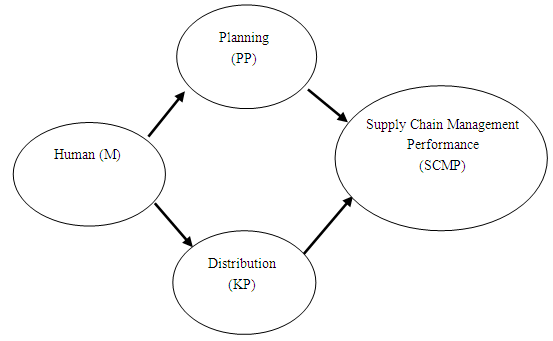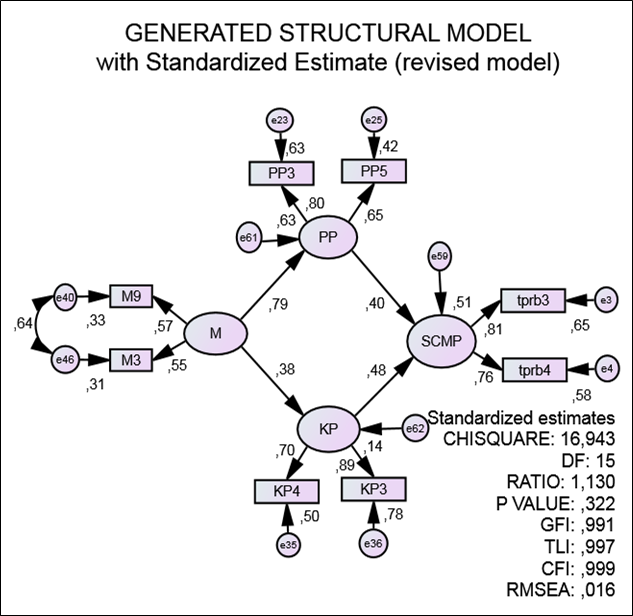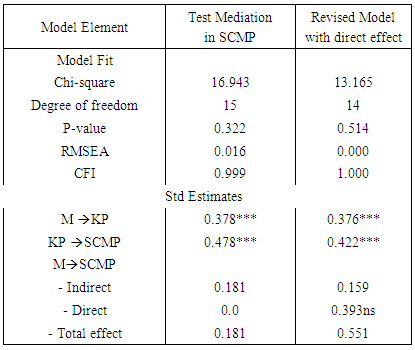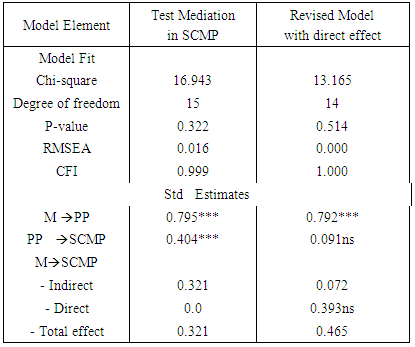-
Paper Information
- Previous Paper
- Paper Submission
-
Journal Information
- About This Journal
- Editorial Board
- Current Issue
- Archive
- Author Guidelines
- Contact Us
Journal of Logistics Management
2016; 5(1): 16-21
doi:10.5923/j.logistics.20160501.03

Supply Chain Management Performance of Subsidized Fertilizer in Indonesia: From Perspective Planning, Distribution and Human Factor
Aswin Naldi Sahim, Nik Kamariah Nik Mat
Othman Yeop Abdullah Graduate School of Business, Universiti Utara Malaysia, Sintok, Malaysia
Correspondence to: Nik Kamariah Nik Mat, Othman Yeop Abdullah Graduate School of Business, Universiti Utara Malaysia, Sintok, Malaysia.
| Email: |  |
Copyright © 2016 Scientific & Academic Publishing. All Rights Reserved.
This work is licensed under the Creative Commons Attribution International License (CC BY).
http://creativecommons.org/licenses/by/4.0/

Nowadays, majority of companies start to be aware that supply chain management is a very important issue due to its significant effect to the success of the company. The main objective of this study is to identify the relationship between alignment plan, distribution and human factors on supply chain management performance of the subsidies fertilizier products in Indonesia. A total of 800 questionnaires were distributed to the location of the study and 580 or 73% of respondents rate was raised consisting of distributors and retailers of subsidies fertilizier. Data from 513 or 64% respondents were analyzed using the Structural Equation Modeling (SEM) with Amos. Findings indicated that government policy, alignment plan and the distribution significantly affect on supply chain management performance of the controlled items. While the human factor has no direct relationship to the supply chain management performance. However, the human factor plays an important role because they are critical subject to the success of the alignment plan and distribution. While factors such as alignment plan and distribution is a mediation between the human and supply chain management performance. This study suggests the goverment to put more attention on the alignment plan, distribution, and human factors in making fertilizer distribution accord with the designation at the right time and location, with the form, right amount of quantity and quality, and prices to suit the conditions. In this study the determinants of supply chain management performance measurement are expected to give contribution to the government policy and academic literature. For future studies, such studies can be used for any other commodity subsidies.
Keywords: Supply chain management performace, Alignment plan, Distribution, Human factor, Stuctural equation modeling (SEM)
Cite this paper: Aswin Naldi Sahim, Nik Kamariah Nik Mat, Supply Chain Management Performance of Subsidized Fertilizer in Indonesia: From Perspective Planning, Distribution and Human Factor, Journal of Logistics Management, Vol. 5 No. 1, 2016, pp. 16-21. doi: 10.5923/j.logistics.20160501.03.
Article Outline
1. Introduction
- Nowadays, the huge part of the company has realized that the supply chain (SC) is an important thing of the business. However, supply chain itself is not enough to make the success because only companies that implement supply chain efficiently and effectively can achieve it. Therefore, supply chain activities need to be as effective as possible, and for this purpose it can be processed through supply chain management (SCM) (Janvier-James, 2012) [1].The basic objective of supply chain management is to connect all of the chain of the supply to work together to maximizing the productivity, adding value, reducing the cost, increasing customer satisfaction, thereby increasing the competitiveness of enterprises (Finch 2006) [2].In order to assess whether the management of the supply chain has been running at its optimum value or not, measuring the supply chain management performance (SCMP) is very important thing to do. Gunasekaran and Kobu (2007) [3] states that measurement of the performance of supply chain management can determine whether the success has been achieved, customer needs are met, a better understanding of the process, find out the errors and things that are not necessary to understand the problems and opportunities for repair, provide a factual decision to get progress, facilitate cooperation and more open and better communication.This study will evaluate and the measure the supply chain management performance on subsidized fertilizer. This is because fertilizer is one of the facilities to increase the production and productivity of agricultural land. Thus the fertilizer gets huge attention from the government to achieve national food security.As a strategic production facilities, the government has made two main policies of fertilizers; First, provide fertilizer subsidy to farmers, and Second, set the fertilizer supply chain management (Ditjen PSP Kementan, 2012) [4].The distribution of fertilizer from the factory to the farmers by the Government through the SOE (State Owned Enterprises), namely PT. Pupuk Indonesia (Holding) along with distributors and retailers through supply chain management system monitoring goods (Ministry of Agriculture, 2012) [5]. With that manure fertilizer is expected to be available to farmers in 6 right; right quantity, right type, right time, right location, right price and right quality. Furthermore, land productivity and production of rice is expected to be improved, and further increase farmers' income and the availability of rice nationwide.There are several phenomena that occur in the supply chain management performance subsidies fertilizers: 1) Based on BPS (2013) [6] that the productivity of rice plants in the past five years is still low and even decreased in 2011. And also increase rice production in the last five years there has been significant, 2) Based on statistics from PT. Pupuk Indonesia [7], showed a considerable difference between the allocation of fertilizer subsidy set by the Ministry of Agriculture to the potential needs. Also there is a considerable difference between the subsidized fertilizers allocated to the realization of its distribution. And 3) Humans are the most important resource in achieving an organization's business objectives. Although an organization system has been good, but if the human factor is not good, it is difficult to achieve organizational goals. From the issue of the above issues may occur because of the things that are less good at planning factor, distribution and human performance supply chain management of fertilizer subsidies.In connection with the problems already mentioned, the main purpose of this study is to empirically evidence the relationship between planning, distribution and human performance supply chain management of fertilizer subsidies.
2. Literature Review
2.1. Supply Chain Management Performance (SCMP)
- According Simchi-Levi, Kaminsky, & Kimchi-Levi, (2003) [8], the performance of supply chain management is defined as operational excellence, a method used to coordinate the activities of suppliers, manufacturers, distributor, and retailer, therefore commodity produced and distributed in the correct amount, to the right location, and at the right time. The basic idea of this definition is that the supply chain must be controlled so that fast and reliable, cost effective, and flexible enough to meet customer requirements.
2.2. Relationship between Planning and SCMP
- The first step in assessing the performance of supply chain management is to analyze plan activities, that is supply and demand balancing act, with the obligation of the authority's budget and procurement of goods in anticipation of fulfilling customer requirements (Gunasekaran & Ngai, 2004) [9]. The findings by Hayat et al., (2014) [10] and Agus. (2010) [11] also found that a plan for the supply chain can improve the performance of supply chain management. Hence, it is hypothesized that: H1: Planning has a positive effect on supply chain management performance.
2.3. Relationship between Distribution and SCMP
- Supply chain management performance is determined by the next step, that is the transmission activities to provide goods and services, including order management, transportation management, and warehouse management plans to meet the demand (Gunasekaran & Ngai, 2004) [9]. In line with the findings of the studies (Ghasemi & Mohaghar, 2011) [12], and Bigliardi & Bottani (2010) [13], hence, it is hypothesized that: H2: Distribution has a positive structural effect on supply chain management performance.
2.4. Relationship between Human Factor and Planning
- According to Nik Mat (2005) [14] that the human factor is crucial in the plan, because there are activities that strengthen customer relationships in terms of getting orders and expedite the order. It should therefore be fostering human behavior in this case is a sales and distribution company officers. The findings of the study Janver-James. (2012) [1] and Fishbein & Ajzen (1975) [15], that human factors directly affect plans. Hence, it is hypothesized that: H3: Human factor has a positive effect on planning factor
2.5. Relationship between Human Factor and Distribution
- Theeranuphattana & Tang (2008) [16] suggest using human with performance of distribution could provide the followings: 1) reliability, which provides that the right to the right place, at the right time, in the right condition, in the right amount, with the correct documentation, to the customer is right, 2) responsiveness, Speed provide goods to customers, and 3) flexibility or agility in responding to market changes in order to obtain or maintain a competitive advantage. Research findings by Janver-James. (2012) [1], and Bologne & Singleton (2006) [17] suggest that human factors have a direct impact on the reliability of distribution. Hence, it is h ypothesized that: H4: Human factor has a direct effect on distribution factor
2.6. Mediation Effects of Planning and Distribution on the Relationship between Human Factor and SCMP
- Gunn & Ritchie (2012) [18] study that the proper attitude of a man has an indirect effect on the performance of supply chain management. Hence, it is hypothesized that:H5: Planning factor mediates the linkage between the human factor and supply chain management performance.H6: Distribution factor mediates the linkage between the human factor and supply chain management performance.
3. Methodology
3.1. The Theoretical Research Model
- This section explores the linkages between factor of planning, distribution, human and supply chain management performance on subsidized fertilizer in Indonesia.Therefore, this flowchart provides causality variables tested (Sugiyono, 2013) [19]. In accordance with the theory, the supply chain management performance (SCMP) is the dependent variable, while the alignment of planning (PP), Human (M) and the reliability of the distribution (KP) are independent variable. Besides, PP and KP is a mediator variable between M and supply chain management performance (SCMP). Theoretically, the model is presented in Figure 1.
 | Figure 1. The theoretical research model |
3.2. Sample and Data Collection
- Sampling is one of the most influential aspect for the success of research. According to Santoso (2013) [20] model SEM with variable amounts of up to five pieces and each latent variable is explained by three or more indicators, a sample size of 100-150 is considered adequate. However, if the correlation between the indicators of the latent variables are not strong enough (below 0.6) the sample size should need to be increased to 300. Meanwhile Hair et al., (1998) [21] states that the number of samples using SEM to be effective on a sample size of 150 - 450. Therefore, to get a good and acceptable result, this study uses a sample size of 450 respondents.In this study the sampling of the population carried out two stages. The first stage, the selection of the provincial area with stratified random sampling method. Five from 33 provinces in Indonesia have been selected. According to the writer's observation of the province is quite representative as national granary area with a varied infrastructure. The second stage, the selection of the number of samples in each province conducted with random table and systematic random sample of 450 of the total plan (Sekaran, 2000) [22].To obtain a valid questionnaire items and reliability, the researchers has conduct three (3) times field trials, where each trial uses 40 respondents.Once the questionnaire items and reliable valid, then eight hundred (800) questionnaires were spread to the respondents, which is twice the sample size required (450). Of these five hundred and eighty (580), or 73% of questionnaires were returned. This amount is 145% of the required sample size. After filtering the data, then as many as five hundred and thirteen (513), or 64%, which can be used for analysis. Both measurements dependent variable and independent variables using a Likert scale (7 = strongly disagree and 1 = strongly agree). (Sugiono, 2013) [18].
3.3. Measurement
- Data processing is done by statistical analysis of SEM (Structural Equation Model), consists of stages; the model identification phase, the test phase measurement model and test phase structural model (Dahlan, 2014) [23].
4. Results
4.1. Demographic Profile of the Respondents
- Many male respondents are mostly involved in company as steel distributors and retailers of subsidies (78.2%), with age (59.3%) between 31-50 years. Meanwhile his tenure as the dominant distributors and retailers 5-10 years (47.8%). Most of the respondents are of high school and higher education (60.1%). Only a few respondents who have received training distributors and retailers of fertilizers (14%) 7.4% of them received an award. Total sales of subsidized fertilizers are generally below 1,000 tonnes per season (85%). Respondents generally have warehouses with an average sale of 500 tonnes (91.2%), and only 32.9% had a fleet of trucks. Total workforce is generally about three (3).
4.2. Generated Structural Model (GM)
- By using a modified index, which gives the covariance relationship between e40 and e46, this research produces a fit generated structural model indicating p-value of 0.322 (p-value> 0.05); ratio of 1.130 (<2); Goodness of fit (GFI) of .991 (> .95); Tucker Lewis Index (TLI) of .997 (>.905); comparative Fit Index (CFI) of .999 (>.95) and Root mean square error of approximation (RMSEA) of 0.016 (<.08). Thus this structural model achieved all goodness of fit indices rendering it suitable for generalization to be made to the population. Therefore, the explanation of direct hypotheses findings are based on the results of the Generated Structural Model (Figure 2).
 | Figure 2. Generated Structural Model |
4.3. The Regression Estimates
- The generated produces regression standardized beta estimates as in Table 1.
|
4.4. Planning (PP) is a Mediator between Human (M) and Supply Chain Management Performance (SCMP)
- From the comparison of test results of direct and indirect relationships, having entered the M factor, the model support the findings that the PP gives a significant mediation on relationship between M and SCMP (Table 2). It can be concluded that H5 is accepted.
|
4.5. Distribution (KP) is a Mediator between Human (M) and Supply Chain Management Performance (SCMP)
- From the comparison of test results the relationship of direct and indirect influence, having entered the M factor, the model supported by the finding that KP is not a significant mediator on the relationship between human and SCMP (Table 3). It can be concluded that the hypothesis H6 is not accepted.
|
5. Discussion
- The research concludes that the policy in terms of planning and distribution has a direct and significant effect on the supply chain management performance of fertilizer subsidies in Indonesia. Of the three variables, it turn out the distribution (KP), plays a more important role for the success of supply chain management performance on subsidies fertilizer. This will determine distribution of fertilizers that can be available according to the needs of farmers in right quantity, type, time, right location, right price and right quality. This is in line with the findings of the Darwis & Chairul (2007) [24] that the shortage of fertilizers to farmers in Indonesia is not caused by insufficient production of fertilizers but rather due to the weakness of the distribution system.According to the researcher analyzes that the problems that almost always happens is a shortage of fertilizer, especially in the growing season for farmers to grow simultaneously, thus requiring large amounts of fertilizer. In the event of disruption in the distribution system, farmers will have difficulty in obtaining fertilizer, or better known as the phenomenon of "scarcity of fertilizer". Similarly, another problem in the distribution, storage and marketing are generally stem from the distribution system that has not been effectively coordinated.Planning (PP) is a second factor that significantly affect the performance of supply chain management of subsidized fertilizer. Planning is the relationship between budget planning for the distribution of fertilizer subsidy quota set by the government (Ministry of Agriculture) and the needs of fertilizer according to customer demand (farmers). According to the analysis, the significant influence of the planning to be successful performance of supply chain management as far as experience has shown that with the budget constraints the government will create two conditions, namely: (1) a subsidized fertilizer was given priority to farming crops are generally small scale, and (2) the calculation of the total volume of subsidized fertilizers for farming food crops based on acreage times the recommended dose of fertilizer. The first condition, it may cause leakage of fertilizer subsidies to non-subsidized fertilizer market. The second condition, causing total volume of subsidize fertilizer to be much lower than that required farmers.Furthermore, planning also mediate the relationship between humans and supply chain management performance. In other words, the human factor has no direct influence on supply chain management performance, but the performance of supply chain management begins with the human factor, because the success of the planning and distribution is influenced directly by human factors. This is consistent with research of Gunn & Ritchie (2012) [18] of Development in Construction Supply Chain Management and Prime Contracting that the proper attitude of human has no direct influence on the performance of supply chain management. With the good and bad of human factors will influence the success and reliability of the distribution plan, the next will determine the success of supply chain management performance monitoring subsidized fertilizer.
6. Conclusions
- Planning and distribution have significant influence on supply chain management performance of subsidized fertilizer.Although the human factor does not directly affect the performance of supply chain management of subsidized fertilizer, but its role is important because the human factor significantly influence the planning and distribution factors.Planning is a full mediator of the relationship between human factors and performance of supply chain management of subsidized fertilizer while distribution is not.
7. Managerial Implication
- This study reveals how important planning, distribution and human factors in the performance of subsidized fertilizer supply management, so that relevant organizations can determine the pace and attitude in making decisions for future improvement.This research discover that some important aspects of supply chain management performance of subsidized fertilizer in Indonesia need to be addressed in the future, so that policies can be adapted to the condition of these factors.
 Abstract
Abstract Reference
Reference Full-Text PDF
Full-Text PDF Full-text HTML
Full-text HTML

